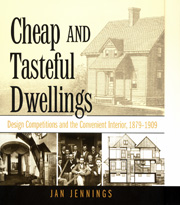How design competitions for inexpensive homes a century ago have influenced architecture today
By Susan S. Lang

Obscure house designers competing to design inexpensive but well-thought out houses for ordinary people 100 years ago quietly but assuredly altered American architectural history, asserts design historian Jan Jennings in her new book, "Cheap and Tasteful Dwellings: Design Competitions and the Convenient Interior, 1879-1909" (University of Tennessee Press).
The book tells the stories of 42 competitions, launched by Carpentry & Building magazine in 1879, and its 86 winning designs, designers and a host of near winners and losers over a 30-year period to offer a glimpse of architectural history never before told.
"The contests allow us to freeze time just long enough to examine the encapsulated fragments of several architectural and cultural contexts and to suggest interpretations about the competitions' effect on the competitors and the magazine's readership, houses, and design," writes Jennings, professor of design and environmental analysis at Cornell. She notes that the contests also shed light on the housing problem of the time -- too few affordable houses for the majority of Americans, too few architect-designed houses.
"This story is really about the competitors' attempts to apply an interior architectural theory to houses -- their designs represented experiments in designing practical houses that function better in their interiors for ordinary life, from proper working heights for countertops and plenty of natural lighting to good cross ventilation," says Jennings.
The 345-page book with its 184 illustrations discusses the philosophy behind the competitions; the characteristics of the winners; the nature of architectural practices during the period; the winning competition designs; and the biographical stories behind the winners and losers.
Jennings is also the co-editor of Perspectives in Vernacular Architecture, a new scholarly journal, and the director of Interior Archetypes, an ongoing, Web-based clearinghouse for design research that offers evidence-based research about contemporary interior architecture and design.
Media Contact
Get Cornell news delivered right to your inbox.
Subscribe